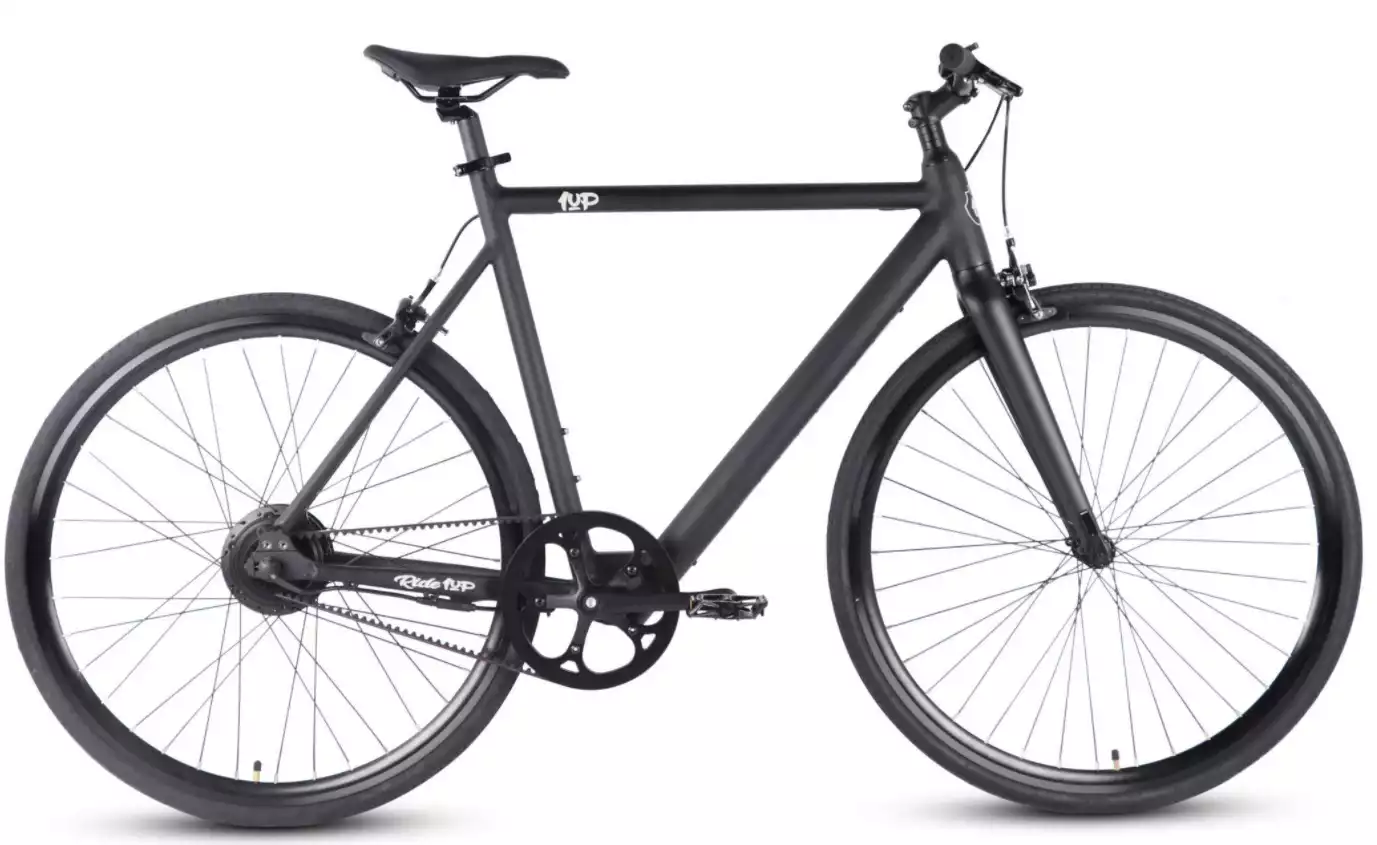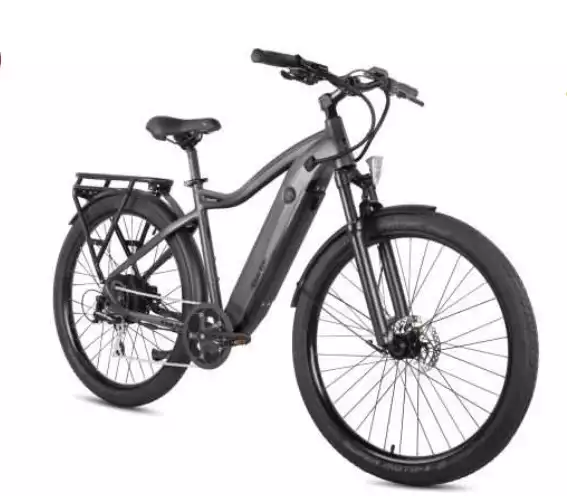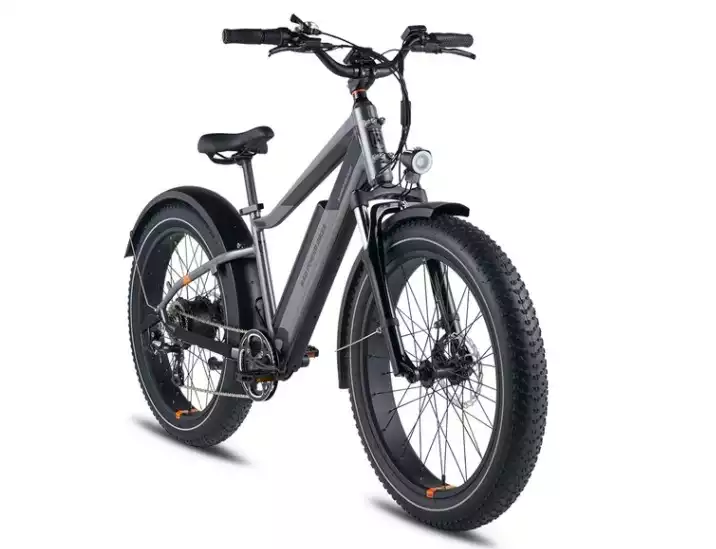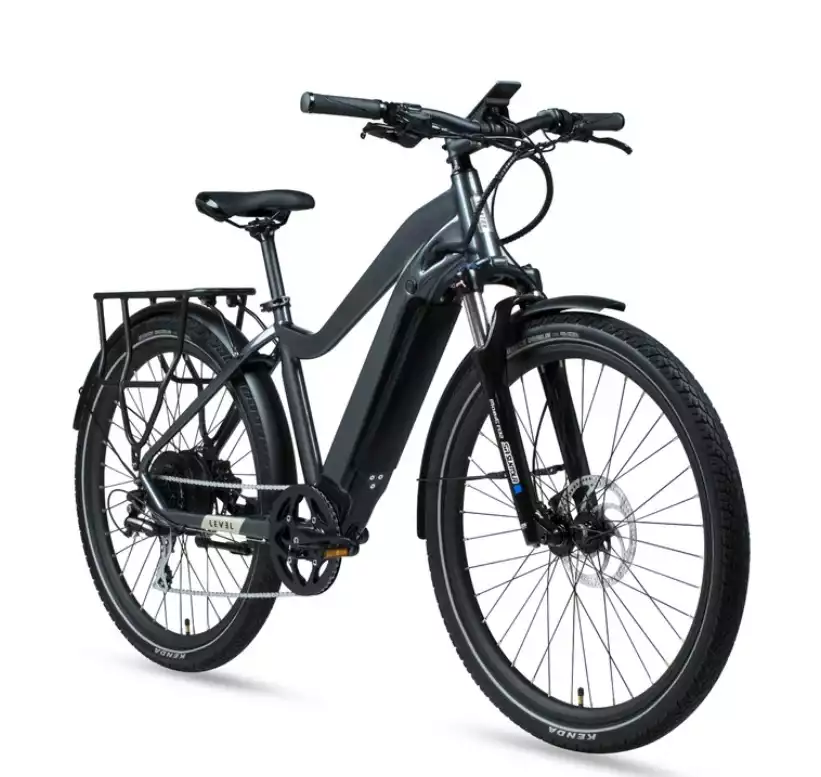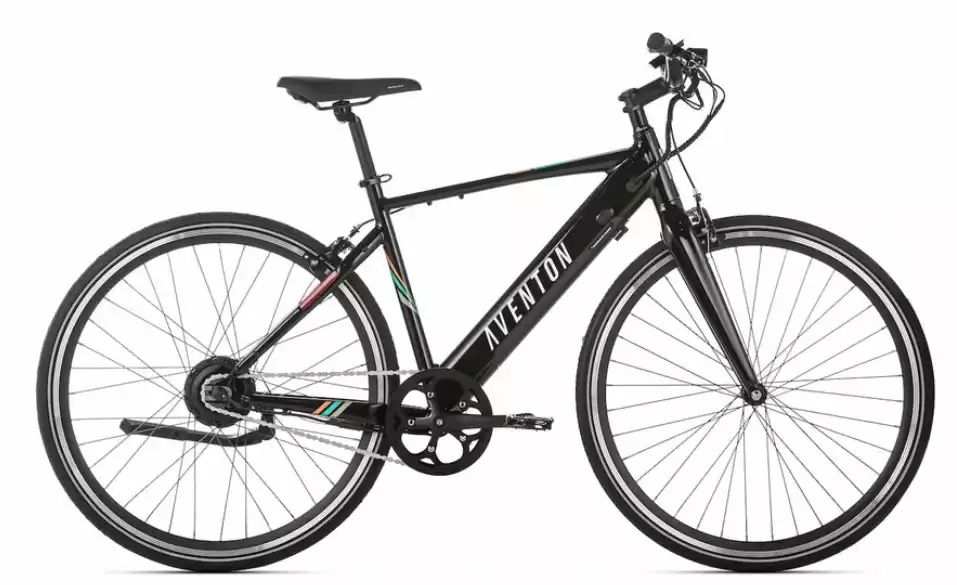The last several years have brought a lot of changes in many people’s lives. As we return to the office, the idea of commuting to work every day in a big, expensive, gas-powered car has lost its appeal for many people. Thus, the surge in popularity of e-bikes for commuting!
But what bike is best for you?
In this article, we’ll go over seven great bikes, as well as everything you need to know to pick the best commuter e-bike for your ride. We’ll discuss features to look for, which bikes are best for which types of commutes, and go over some of the best and most cost-efficient bikes on the market today.
By the end, you’ll be able to decide with confidence and pick the best electric bike for your individual commute.
Electric bikes built for everything and priced for everyone. Shop Rad Power Bikes, America's #1 electric bike brand. Get out. Go further. Ride Rad.
The Best Electric Bikes For Commuting
1. Ride1Up Roadster v2
Simple, fast, and fun, this electric bike is as clean as it gets. With a completely concealed battery and quiet motor, onlookers aren’t going to understand how you pedal so fast.
The Roadster is one of the more unique e-bikes on the market. It’s incredibly affordable, fast, and phenomenally well-designed. It’s a 33 lb belt-driven fixie that’s styled like a road bike with flat handlebars. It’s got a long reach and low, narrow handlebars, promoting an aggressive riding position.
Between the narrow handlebars and the bike’s low weight, it feels extremely maneuverable, allowing you to dart in between cars while giving you extra room to ride in the bike lane. An integrated battery and slim frame tubes mean that it’s tough to tell that this is an e-bike, even if you know what you’re looking for.
The Roadster is an incredible bike, but it’s not for everyone. In addition to the aggressive riding style, its single gear, small battery, and skinny road tires limit the types of commutes that it works with.
2. Ride1Up 700 series
An excellent electric biking experience. Hydraulic fork, hydraulic brakes, color display, 14 ah Samsung cells, Schwalbe Super Moto X tires, fully integrated aluminum frame.
The Ride1Up 700 series offers incredible performance for its price. It’s a fully-featured commuter e-bike with an 8-speed drivetrain, thick 2.4″ tires, a 750-watt motor, and about 27 miles of range on max pedal assist.
Features like hydraulic disc brakes, a hydraulic front suspension fork, a full-color LCD display, and included lights, racks, and fenders mean that you get a LOT of bang for your buck. At 62 lbs with racks and fenders, the bike isn’t super heavy, either.

Instead, it’s almost at a perfect goldilocks-esque equilibrium with all of its features.
The 700 series is available in both crossover and step-through frames. All versions of the bike are very upright and accessible, with the hefty tires and front suspension contributing to comfortable rides. A thick, cushy saddle adds a bit of extra help here, although it’s hardly needed.
One of the most noticeable features of the 700 series is how darn fast it is. As a class 3 e-bike, it’s capable of hitting 28 miles per hour on pedal assist. What’s remarkable is how easily and consistently it hits that speed. As long as you’re on reasonably flat ground, doing almost thirty miles an hour is nearly trivial.
The small downside of the 700 series is a lack of low-speed torque compared to similarly powerful e-bikes. As long as you’re pedaling, you probably won’t notice this deficit. If you use the throttle alone to try to start up a steep hill, however, you may notice that the bike struggles a fair bit.

If the other bike can’t beat the 700 series in a meaningful way, you probably shouldn’t pick it.
This is unlikely to be a problem on most commutes, but if you know you’ll be relying entirely on the throttle to carry you up a steep hill, you might want to choose a different bike. Again, this is not a problem you’re likely to notice if you pedal, especially with the eight-speed drivetrain.
With a tiny bit of human help, the 700 series does phenomenally well up hills.
The blend of low cost, great parts, and great performance make the 700 series a great starting point for your commuter bike comparisons. This might not be the bike you wind up picking, but this should be the model you compare the other bikes against.
If the other bike can’t beat the 700 series in a meaningful way, you probably shouldn’t pick it.
3. RadRover 6 Plus
The RadRover 6 Plus is a reliable, understated e-bike. It has an excellent reputation and an ever-expanding customer service. It offers great performance at a reasonable price.
A powerful, 7-speed fat-tire e-bike, the RadRover 6 Plus is ideal for commutes with bumpy or uneven terrain — or for taking out on trails on the weekends. It’s got a 750-watt motor, hydraulic disc brakes, and big 4″ fat tires that help keep your ride incredibly smooth.
Front suspension, fenders, and included lights help keep you clean and safe while you ride.
The RadRover 6 Plus is a big, 72 lb bike. It feels a bit slower than the Ride1Up 700 series on flat ground, although it does climb hills much better on throttle alone. The motor feels powerful, keeping the ride fun, but this is definitely a hefty bicycle. You don’t want to ride this thing when it’s out of batteries.
Like other Rad Power Bikes bikes, this is a class 2 e-bike, which means it’s limited to 20 miles an hour. This means less speed, more battery life, and less hassle worrying about laws in your state. Class 3 e-bikes, like the Ride1Up 700 series, are limited to 28 miles per hour, which is a bit faster.
The styling on the RadRover (and on most other fat-tire ebikes) is more reminiscent of a strange motorcycle or moped than a bike. The big, thick tires, thick tubes, and large lights make this bike seem like it should have a motor.
It does, of course, but it’s nowhere near as subtle about it as the Ride1Up bikes above.
Without a rear rack and with a higher base price than the 700 series, this bike might not be your first choice if you’re commuting on paved roads. If your commute involves rough surfaces, however, or if you plan to go riding on dirt trails in between commutes, the RadRover 6 Plus is an excellent choice.
It’s powerful, durable, and comfortable, enabling you to ride anywhere with ease and comfort.
4. Radcity 5 Plus
Reimagine your ride with the all-new RadCity 5 Plus! Getting around on this comfortable, European-styled electric city bike is so easy and so fun, you’ll choose it over your car. Every time.
A 7-speed city commuter bike with included racks, the RadCity 5 Plus is a great alternative to the Ride1Up 700 series. It’s got a 750-watt motor, hydraulic disc brakes, and a front suspension fork, giving you the tools you need to ride comfortably and fast.
The RadCity 5 Plus boasts about 31 miles of range on the highest level of pedal-assist. While this is higher than most of the other bikes here, this bike has the same caveat as the RadRover 6 above. As a dedicated class 2 e-bike, the RadCity 5 Plus can’t go faster than 20 miles per hour.
This means less power spent getting the bike up to higher speeds, fewer issues with legality in some states, and more range.
The RadCity 5 Plus is 64 lbs or so. It features 2.3″ tires and utilizes an upright riding position. The bike comes with racks, fenders, and a light, keeping you and your gear clean and visible.
While the RadCity 5 Plus’ base price is higher than the Ride1Up 700, it doesn’t suffer from the same low-speed torque issues. It’s ideal for slightly hillier commutes, states with legal issues over class 3 e-bikes, and commuters who prefer a bit of extra range over a bit of extra speed.
5. Aventon Level
An upgrade to Aventon's flagship commuter ebike, Level.2 is as innovative as it is efficient. A fully integrated battery, four integrated lights, and a front suspension fork provide ultimate comfort and safety no matter the terrain or time of day.
The Aventon Level is very, very similar to the Ride1Up 700 series in terms of specs. While it utilizes a coil-spring fork instead of a hydraulic one, it’s got the same 8-speed drivetrain, similar hydraulic brakes, similar 2.2″ wide tires, and a similar 750-watt peak hub motor.
It even looks similar, sporting the same greyish thick, curved tubes on the frame.
This is definitely not a bad thing. More options are good. The Level comes with racks and fenders, too, making it great for commuting right out of the box. Like most other e-bikes on this page, it provides a stable, comfortable riding position that’ll keep you relaxed on your way to work.
Spec-wise, the Level gets about 25 miles out of a single charge on max pedal assist. It weighs 62 lbs. The motor is a bit smaller than the motor on the Ride1Up 700 series, which means that the Level is a bit slower on flat ground, but it performs very, very, slightly than the 700 series up steep hills.
You’ll want to add a bit of pedal power while climbing on both bikes. Still, the Level can definitely hit 28 miles per hour with only a little help from your legs.
The Aventon Level is an excellent choice for most commuters. It’s got very slightly worse specs than the Ride1Up 700 series in a couple of meaningful categories, but the differences are pretty small. You’ll probably want to price-check both bikes if you’re thinking about either.
6. Aventon Soltera
A sleek, single-speed electric bike (also available in a 7 speed) that is nimble and powerful enough to weave through the jungles of the city yet lightweight enough to carry up a flight of stairs after a day’s work.
A 41 lb e-bike with a 350W rear motor, the Soltera is available as both a fixie and a 7-speed. It’s a light, fast bike that keeps you more in touch with your surroundings than the thick tire front-suspension bikes above.
As a class 2 e-bike, it’s not going to break any speed records, but you’ll definitely be able to get to work quickly without too much work.
The Soltera is designed to be light and fun. Its battery is fairly small, giving you about 18 miles per charge on the max pedal assist.
Unlike the Ride1Up Roadster, however, you can remove the battery quite easily, meaning you can pull the battery out and charge it while you’re at work or even ride the bike with no battery on leg power alone. It’s got skinny road bike tires, keeping the bike light and minimizing rolling resistance for maximum efficiency.
In terms of speed, the Soltera offers similar motor power to the Ride1Up Roadster. It’s a heavier bike, meaning it’s a bit slower up hills, but the extra battery capacity helps the motor output a bit more power at speed, keeping your average speed high.
You’ll have no problems with this bike on flatter commutes. If your commute has a lot of hills, you’ll do fine as long as you’re willing to pedal, especially if you choose the 7-speed option.
While the Soltera is comparable to the Roadster in terms of specs and kit, it’s got very different geometry. The Soltera has a very standard 15″ reach and normal width handlebars. It’s not going to give you a fully upright, cruiser-style ride, but it’s definitely more relaxed than the Roadster.
The biggest obstacle you’re likely to hit when commuting on this bike is the lack of accessories. If you need racks or fenders for your commute, you’ll have to purchase them separately and install them. Be sure to factor in these additions to the cost of the bike if you’re comparing it with other models with racks and fenders.
The Aventon Soltera is a perfect pick for someone who wants a light bike for short commutes. The removable battery makes it a lot more flexible than the Ride1Up Roadster, while the option for adding gears means you can tackle hillier commutes with an ultra-light e-bike.
Its smaller motor keeps the top speed under 20 miles per hour, however, and the thin tires mean it’s not great for commutes with bumps and rough pavement.
7. Lectric XP Lite
A fun, foldable, fat tire, single-speed electric bike to get you around and in the suburbs.
This is a great choice if you have limited space or you don't want to lift a heavy, bulky bike when you want to take it with you in the car.
An unconventional commuter option, the Lectric XP Lite is a cheap, small, foldable e-bike with a 300-watt nominal, 720-watt peak rear hub motor. With a range of about 15 miles and a top speed of 20 miles per hour, the bike manages to compete favorably with some of the smaller non-folding e-bikes above.
When it comes to storage, however, the XP Lite Lectric has a big leg up on the other bikes. It can fold down to a 36″ by 16″ by 26″ package, enabling you to stow your bike in a car trunk, under your desk, or in an overhead bin on an airplane without any tools.
The XP Lite’s foldability is a major boon when it comes to storage, but it’s worth noting that it doesn’t make transporting the bike trivial. This is still an e-bike and it weighs 46 lbs. In other words, just because the bike folds up to be small doesn’t mean it’s not still heavy.
A set of optional extras make the Xp Lite Lectric a surprisingly good option for commuting. You’ll have to pay a bit extra, but you can get front and rear racks as well as a pannier bag to help you carry a few dozen pounds of extra gear on the bike.
You won’t be able to find fenders, however, which means you might get some dirt on your clothes when you commute.
Big wheels tend to translate to smooth rides. The Xp Lite Lectric has standard width 20″ tires, which make the ride somewhat bumpy. It’ll do fine on paved roads or grass, but expect a bit of bumpiness that you wouldn’t get with a full-sized bike.
If you’ve got hills, you’ve got a long commute, or you’re after a smooth ride over rough terrain, you’ll want to consider a different bike.
The big draw from the Xp Lite Lectric is its cost. This folding e-bike has a base price that’s lower than anything else on this page by a decent margin. When you start throwing in racks and accessories it starts creeping up on the other bikes, but it’s still an impressive deal.
If you need a bike that folds up for easy storage and you’re looking for an extremely inexpensive e-bike for a short commute on fairly flat ground, the Lectric XP Lite is perfect. It’s compact, inexpensive, and powerful enough to hit nearly 20 miles per hour on flat ground.
If you’ve got hills, you’ve got a long commute, or you’re after a smooth ride over rough terrain, you’ll want to consider a different bike.
Why Go Electric?
Now that we have seen a few bikes, it’s worth discussing why electric bikes are such a good commuter option. A road bike (or a hybrid bike) with a skilled rider is lighter, less expensive, and can even go faster than many electric bike models around today. So why should you spend extra money on an e-bike?
The answer is fatigue. Going on a long journey at 20+ miles per hour on your regular road bike is definitely possible if you’re very fit, but it’s not something you’ll want to do every day.
Even more than that, it’s not something you’ll want to do early in the morning before work, and it’s probably not something you’ll want to do after a long, hard day at your job.
Biking hard is tiring, you get very sweaty, and you’ll probably find that your mood and energy levels are affected by the amount of exertion you put in on your commute. This isn’t to say that you can’t commute on a regular bike, but rather that it’s an option that’s best for athletic riders with short commutes.
Electric bikes expand these conditions and make cycling to work attainable for people of all fitness levels with commutes of low double-digit miles each way. With an electric bike, you don’t have to worry about sweating to climb a hill or maintain a fast pace.
Instead, you can let the e-bike’s motor do the work for you, cruising at up to 20 miles per hour on throttle alone or 28 miles per hour with a bit of pedalling. When you’re feeling fresh and energetic, you can ease off the throttle and let your legs do as much of the work as you’d like.
When you’re having a rough day or you’re running late, however, you can unleash the motor and get your commute over fast without having to worry about tiring yourself out or sweating in your work outfit.
What To Look For In An Electric Bike
Advances in battery and motor technology have made electric bikes better than ever. These days, there’s a whole slew of excellent bikes to choose from on the market. Here are some of the qualities you should consider when choosing the right bike for your commute.
Range
Most modern electric bikes are limited by laws, not motors. This means that range, not speed, should be the first thing you look at. The range of a bike is determined by a number of factors, including the power of the motor, the size of the battery, the way the controller is set up, and the weight of the bike.
If a bike can’t get through your commute on a single charge, it’s probably not the right choice.
When considering range numbers, take any manufacturer-provided data with a grain of salt. While a handful of e-bike manufacturers have very accurate, real-world range testing, the majority give somewhat inflated examples of what the bike might be able to do under the best conditions.
If a bike can’t get through your commute on a single charge, it’s probably not the right choice.
A good guess is to take the amp-hours of the battery and double it. This tends to be close to the real-world maximum range of the bike on throttle-only.
In a lot of cases, this guess will be a bit under what the bike is capable of, but if this number is significantly less than what the manufacturer suggests the bike can do, you’ll want to find real-world testing data to verify their claims.
One big thing to consider when comparing the range is how easy it is to charge the battery. Bikes with a fully internal, not-easy-to-remove battery will need to get you to your destination and back on a single charge.
Bikes with a removable battery might not, as you might be able to pop the battery out and charge it while you work.
Power
While the top speed of your e-bike is likely regulated by law, its acceleration and hill-climbing performance are not. The best thing to look at here is the torque of your bike’s motor, usually measured in newton-meters.
If you can’t find this measurement, you can still take a pretty close guess by considering things like the wattage of the motor, the wattage of the controller, the range of the bike, and the weight of the bike. Big motors generally correspond with more power, especially if they’re paired with big controllers.
If the wattage of the controller is bigger than the wattage of the motor, that usually means the bike will outperform bikes with similar motor wattage at the cost of range.
Bikes with less range than you’d expect for their battery size also tend to have more power available as a rider, as the decrease in range is often caused by the controller spending more battery power on hills and starts.
Finally, if the bike itself is lighter than the competition, it’ll go up hills a lot more easily with a similar motor.
Power isn’t necessarily a big concern for some commutes. If your commute is mostly flat you probably don’t need to worry about this metric at all. If it’s quite hilly, however, or if there’s a particularly difficult climb that’s especially long, you’ll want to spend some time looking at the motors on the bikes you’re considering.
Racks and Fenders
There are a number of ways to carry things while you bike. Racks are a great solution for some types of cargo, and if you find yourself bringing stuff to work, getting a bike with a rear rack (and possibly other racks and mounting points) will make your commute a lot more realistic.
If you’ve got the sort of job where you can throw your lunch and phone in a backpack and be good for the day, you might not need to worry much about having a rack.
Fenders are a bit less optional for many commutes. As you ride, your tires kick up lots of dirt and water and dust. The faster you go, the more stuff your tires kick up. On a clear, dry day, you can probably get away with commuting to and from work without fenders.
If it rained recently, your commute goes through puddles formed by sprinklers, or if it’s particularly dirty along your commute, you’ll probably find that your pants get dirty from the stuff kicked up by your wheels. Remember that you’ll be going fast on an e-bike, usually between 15 and 20 miles per hour.
This means that your wheels will have a lot more rotational energy than you might be used to, which means there’ll be more dirt and water flying at your pants.
Fenders solve this problem by putting a physical barrier behind and above your wheels. When dirt and water get kicked up by your spinning wheels, they’ll hit the fenders, not your clothes. If you can, try to find a bike with fenders or purchase a set to make your commute hassle-free.
Ride Comfort
Roads aren’t all equal. If you’re in an area with potholes, poorly maintained roads, or unpaved sections in between you and your commuting destination, you’ll want a bike with some considerations for ride comfort.
Look for wide wheels, a front suspension fork, and other considerations to keep your commute comfy. When you get your bike, consider slightly underinflating the tires to increase their shock absorption capabilities or adding seat post suspension to increase the comfort of your ride.
Ride Style
Riding a cruiser feels very different from riding an aggressive road bike. While many electric bikes embrace a fully upright riding position to keep things casual and comfortable, this might not be the best for every rider and every commute.
If you’re an experienced cyclist, you might prefer something that’s a bit more aggressive than the standard beach cruiser. If you’re looking for a more relaxed ride, however, you’ll want to look for a short reach and tall handlebars.
Look at the reach of your bike (the distance between the seat and the handlebars) and the handlebar height to get an idea of how your torso will sit when you’re riding the bike. If you’re an experienced cyclist, you might prefer something that’s a bit more aggressive than the standard beach cruiser.
If you’re looking for a more relaxed ride, however, you’ll want to look for a short reach and tall handlebars.
Weight
Finally, it’s worth thinking about how much the bike you’re considering weighs. The weight of the bike is definitely something you’ll have thought about in relation to its power and range, but it’s also something you’ll have to deal with in its own right.
A 70-lb e-bike is a pain to lift. It’s not trivial to walk the bike up or down stairs, and it might be difficult to store. A 30 lb e-bike is much easier to deal with. Most commuter bikes will be somewhere in between these two extremes.
Think about how you intend to store your bike, what obstacles exist on your commute, and whether you’ll have to put your bike on a rack or move it up or down staircases.
Walk-mode features on many bikes’ controllers can help alleviate some of these issues, but a heavy bike is still going to be hard to lift when it’s necessary to move it vertically.
The lack of gearing means that hills might be an issue (although the motor puts out a lot of power for this bike’s weight), while the integrated battery carries only enough power to go about 16 miles on max pedal assist.
Unfortunately, this is one of the few bikes with a battery that’s difficult to remove for easy charging at work. It’s still a great bike for longer commutes if you’re willing to turn down the pedal assist and put in more work, but the lack of gearing means you’re more likely to break a sweat.
Finally, the tires on this bike are very skinny, even for a city commuter bike. If the road surfaces on your commute aren’t very smooth and even, you might want to consider a different option.
Ride1Up ships Roadsters fairly bare. You’ll need to pick up racks and fenders separately if you choose to get them. You’ll also want to buy a light or two if you plan to ride at night.
The Roadster’s low price, aggressive handling, and powerful motor make it feel a lot like a sports car. It’s a bike that’s fantastically fun to ride. If you’ve got a short commute without a lot of hills, you don’t carry a lot of stuff, and the surfaces you plan to ride on are well paved, it’s an incredible option.

